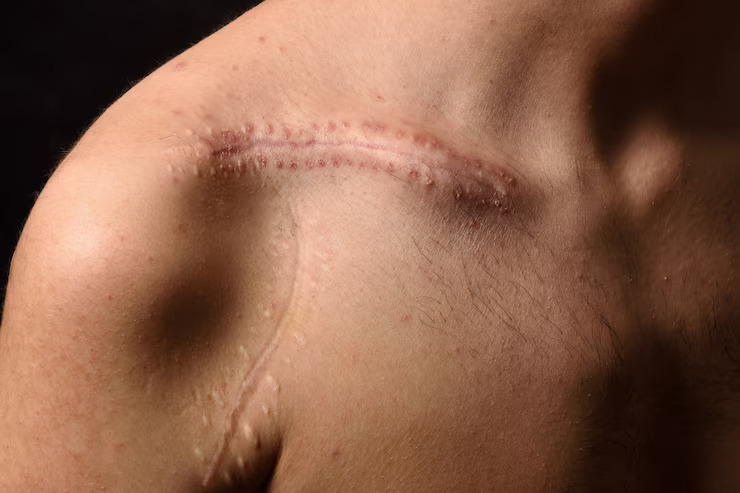Keloid Scars: Diagnosis and Treatment
Keloid scars: Diagnosis and Treatment
A little less than 18 million people are affected by keloid scarring, which is both ugly and frequently painful. It is not necessary for you to spend the rest of your life feeling ashamed because of these scars.
When you undergo keloids removal therapy with the SRT-100TM, which has a remarkable 90% cure rate, you will be able to effortlessly restore your confidence, and these scars do not have to be permanent.

Who or what is a Keloid Scars?
When your skin has been injured, it will result in the formation of a keloid scar. The majority of the time, an accident or a surgical procedure causes this. Within your body, there exist tissues that are referred to as fibrous tissue.
Scar tissues are another name for these tissues, and they are responsible for the formation of scars directly over a wound. There are occasions when an excessive amount of scarring tissue forms, which leads to a hard growth that has the effect of producing extensive scarring. The growth in question is known as a keloid, and it has the potential to be far larger than the initial damage.
Although it is a form of tumor, a keloid is not considered to be cancerous. The majority of the time, they show up immediately following surgery and are regarded as chronic. Burns, piercing your ears, cases of chickenpox, and trauma to your skin are some of the additional factors that might lead to the development of these tumors.
Keloidscars are characterized by the overgrowth of scar tissue beyond the boundaries of the original wound or injury. Unlike typical scars that gradually fade over time, keloids can continue to grow indefinitely and may cause discomfort or itching.
Understanding Keloid Scars
Keloids can be a source of frustration and self-consciousness for many individuals. Understanding the causes, symptoms, and treatment options for keloids is essential for effective management and improvement of their appearance.
Causes of Keloid Scars
- Genetic Predisposition
Individuals with a family history of keloid scars are more likely to develop them themselves, suggesting a genetic component to their formation. - Injury or Trauma
Keloid scars often develop in response to injuries such as cuts, burns, or surgical incisions, particularly in individuals with a genetic predisposition. - Surgical Scars
Surgical wounds, especially those in areas prone to tension, are at risk of developing keloid scars due to the increased production of collagen during the healing process. - Acne Scars
Severe acne lesions can lead to the formation of keloid scars, particularly in individuals with a genetic predisposition or darker skin tones.
Recognizing Keloids
- Appearance
Keloid scars are characterized by their raised, shiny appearance and may range in color from pink to red or dark brown, depending on the individual’s skin tone. - Location
Keloid scars commonly occur on areas of the body prone to tension, such as the chest, shoulders, earlobes, and upper back. - Symptoms
In addition to their distinctive appearance, keloid scars may cause symptoms such as itching, tenderness, or pain, particularly if they continue to grow.
Diagnosis of Keloids
- Physical Examination
A healthcare provider can typically diagnose keloid scars based on their appearance and location during a physical examination. - Medical History
A thorough medical history, including any previous injuries or surgical procedures, can provide valuable insight into the development of keloid scars. - Biopsy
In some cases, a biopsy may be performed to confirm the diagnosis of keloid scars and rule out other skin conditions.
Treatment Options for Keloids
- Corticosteroid Injections
Corticosteroid injections are often used to reduce inflammation and flatten keloid scars by inhibiting the production of collagen. - Surgical Excision
Surgical removal of keloid scars may be considered for smaller lesions, although there is a risk of recurrence and potential worsening of the scar. - Cryotherapy
Cryotherapy involves freezing the keloid scar with liquid nitrogen to destroy excess scar tissue and encourage normal healing. - Laser Therapy
Laser therapy can help reduce the size and appearance of keloid scars by targeting the blood vessels that supply them with nutrients. - Silicone Gel Sheets
Silicone gel sheets are a non-invasive option for managing keloid scars, providing compression and hydration to promote flattening and fading over time.
Prevention of Keloid Scars
While it may not be possible to prevent keloidscars entirely, there are steps individuals can take to reduce their risk, such as avoiding unnecessary trauma to the skin and seeking prompt treatment for injuries or surgical wounds.
Conclusion
Keloids can have a significant impact on an individual’s quality of life, both physically and emotionally. By understanding the causes, symptoms, and treatment options for keloids, individuals can make informed decisions about managing their scars and improving their appearance.
Dr. Praneeth Clinic at Kukatpally is home to some of the most skilled medical professionals and technicians, all of whom are well-versed in the art of treating patients and resolving issues that are associated with their skin. Our clinic is open from Monday through Saturday from 10 a.m. to 1 p.m. and from 5 p.m. to 8 p.m., and it is situated in KPHB colony, which is one of the residential districts with the highest population density.
Keeping in mind the difficult circumstances, we are making an effort to offer solace to each and every patient while simultaneously discussing with the physician and following all of the appropriate standards. To get in touch with us, please schedule an appointment, call 097049 46534 or visit our website .

